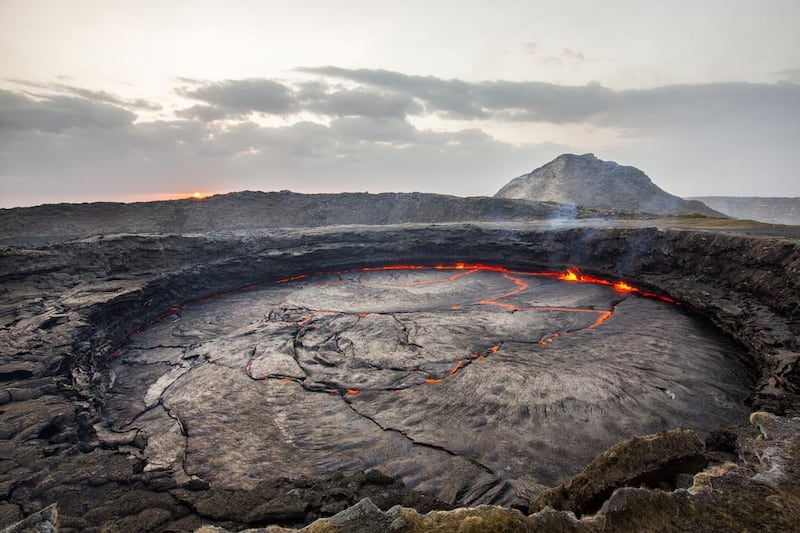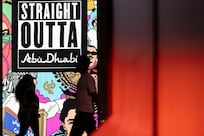The ghost of the high country moves with speed, grace and ease across these bleak moorlands. Every now and then, it pauses, lowers a long, thin, canine nose to the ground and takes a deep sniff. The wolf must know that I'm watching him, from my crouched position behind a rock that even at midday is icy to the touch, but he's so busy chasing the scent of a giant mole rat that he takes little notice of me.
The wolf may be comfortable at such high altitude, but I’m suffering. My breathing is fast and laboured; my head spinning with the first signs of mild altitude sickness. As the wolf vanishes out of sight, I raise myself slowly from my hiding place and continue to walk. As I carefully pace my way across the plateau, half-frozen grasses crunching underfoot, a horseman, swinging a whip and wrapped up warm against the stinging cold winds, gallops past me, while a golden eagle, perhaps the most majestic of all birds, soars high on the thermals.
I’m on the Sanetti Plateau, a vast Afro-alpine moorland four kilometres above sea level in southern Ethiopia. It’s the largest alpine plateau in Africa and forms the centrepiece of the Bale Mountains National Park (www.balemountains.org), which I’m quickly learning is one of the most diverse and exciting national parks I have ever visited.
In the days that follow my wolf encounter, I descend a little from the head-spinning Sanetti Plateau to the Harenna Forest, a place where giant heathers the size of trees cling to the steep slopes and thick, green moss hangs from the spaghetti-like branches. There’s a sense of magic to this place where normally diminutive plants and flowers can turn themselves into three-metre-high monsters.
As I make my way through the under-canopy of the giant heathers, searching for the native Bale monkey, I half-expect to see a goblin scarpering along the trail ahead of me. But there’s plenty more zoologically certifiable wildlife around, including the rare monkeys. Lions, I’m told, are also occasionally seen in and around these forests. Lower still, in the open grasslands, my guide and I walk in the footsteps of the elegant Meneliks nyala (a type of antelope), comical warthogs and herds of petite reedbuck.
The wolves, though, and their open, rarefied mountain plateau home, leave the most-lasting memories from my stay in the Bale Mountains. On my last morning in the park, I meet Neville Slade from the Frankfurt Zoological Society, who tells me that all isn’t well with the ghosts of Sanetti. The Ethiopian wolf, which looks far more like a lanky fox than a classic fairy-tale wolf, is found in only half a dozen specific high-altitude regions of Ethiopia, which makes it the world’s rarest canine.
The Bale Mountains are the species’ real stronghold, home to about half the remaining 450 wolves. But last year, disaster struck. First, there was an outbreak of rabies spread by domestic dogs who had wandered onto the Sanetti Plateau, which wiped out many of the wolves. Then, just as the authorities were getting the rabies outbreak under control, came an even more serious outbreak of canine distemper that killed even more wolves. In the past year and half, half of the Bale Mountains’ wolves died. “If we get these disease outbreaks under control then the wolf population will recover,” says Slade, “but if we can’t, or if there’s another outbreak of disease or some climatic disaster, then the future for the Ethiopian wolf will not be good.”
The future seems to be changing everywhere I go in Ethiopia. At the opposite end of the country from the Bale Mountains, and the opposite end of the universe in every other way, is the Danakil Depression. A few days after shivering my way across the frigid Sanetti Plateau, I find myself sweating, even at midnight, from a combination of heat and fear as I gingerly clamber to the rim of an angry live volcanic cone, trying my best to avoid the sulphurous clouds of poison gas to peer down into a bubbling, boiling red lava lake.
The Danakil Depression, which spreads across Ethiopia, Djibouti and Eritrea, is the lowest point in Africa and one of the lowest on the planet. It’s also the place in which Africa is being torn in half. The Danakil is where the Great Rift Valley, a great tear in the Earth’s surface, first hits Africa. Slowly, it’s gouging Africa into two. Don’t worry though, you needn’t vacate the area quite yet – scientists believe this action will take another 10 million years or so.
The Danakil has a fearsome reputation. It has the hottest year-round average temperatures on Earth; it’s one of the most seismically active corners of the continent; and on account of its extreme climate and once less-than-welcoming Afar tribespeople, it wasn’t until about 80 years ago that much of the area was first explored and mapped by a westerner (the English explorer Wilfred Thesiger, who later spent so long in the Middle East that he earned the nickname Mubarak bin London, began his career tracing the route of the Awash River through Danakil).
Today, the welcome is much warmer, but the climate, and pretty much everything else about Danakil, is just as extreme. From the terrifying lip of the Erta Ale volcano, we drive through curtains of sand in which passing camels slip in and out of hazy focus to another volcanic crater – this one full of bizarre, yellow, pink and garish green mushroom-like formations of sulphur rock, among which are hot springs of burning liquid acid. Exploring these sulphur fields, created by volcanic action, I feel like I’m walking through a nuclear coral garden.
I quickly conclude that with its exploding volcanoes and plains of extraterrestrial sulphur formations, the Danakil is one of the most otherworldly places I have ever been, but the best is still to come. On the day before I’m due to leave the area, I wake with the rising sun. Peering out from the open-sided straw-and-twig shelter in which I had spent the night, I see hundreds of camels, moving in a single, long, snake-like line across a simmering salt pan without a horizon. I jump out of bed and rouse my driver from his sleep, and we set off in haste to investigate.
Some minutes later, we catch up with the head of the camel caravan, and find three hardened men, faces scarred and lined by the desert wind, walking with determination through this scene. They are, they inform me, salt miners from the Ethiopian highlands, and every week or so throughout the cooler months of the year, they walk for days at the head of camel caravans hundreds strong to the Danakil’s vast salt pans. Here, they and their Afar companions cut, hack and smash neat blocks of rock salt from the burning ground, lash them to the camels and walk back the way they had come, to sell the salt in the highland markets.
It’s a trade, they tell me, that has been conducted for generations, but as we all arrive at the heart of the salt pan and the men set to work digging up the precious salt, they explain how their future is changing. Cheaper, factory-produced salt has been flooding their traditional markets, reducing their profits, and to make matters even worse, a new road is slowly edging its way off the highland plateau, down across the Danakil wastelands and out into this salt pan.
In the coming months, when the road arrives, it will bring with it trucks that can carry the salt faster, cheaper and easier than these men with their ships of the desert, comprising the final members of one of the world’s last major camel caravan routes.
Echoing the words of the scientist from the Frankfurt Zoological Society, one of the men shakes his head and says: “We will fight the trucks and try to make them use our camels, but in the end, I think the future for us will not be good.”
travel@thenational.ae





